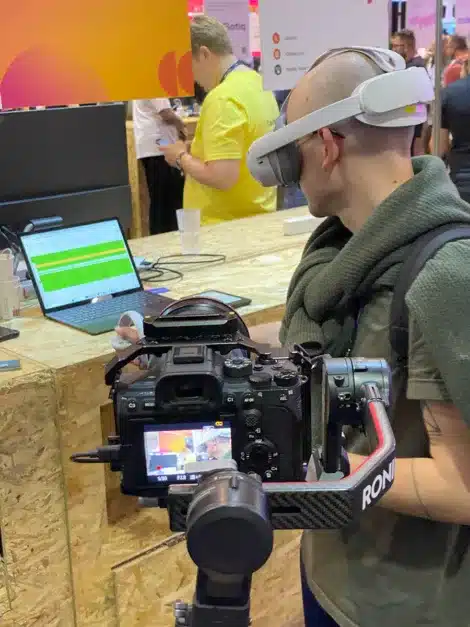If you’re in retail, you’re bound to have heard of eye-tracking. But did you know eye-tracking can now be combined with Virtual Reality (VR)? This innovative technology, which we assessed at Websummit 2023, opens up new possibilities in retail market research. We now propose it exclusively to our customers.
Contact IntoTheMinds for your eye-tracking project
Using eye-tracking in market research
Eye-tracking is a technology frequently used in advertising and retail research. It enables us to understand better consumers’ behavior in the aisle, particularly their purchasing decisions.
Eye-tracking involves measuring where the user’s gaze rests and how long they look at specific objects. By measuring attention, analysts can measure subconscious interests. It is this inference that constitutes the essential interest in market research.
However, eye-tracking implementation in a retail environment came up against a barrier: reconstructing the sales outlet. To conduct an eye-tracking measurement, it was previously necessary to:
- Measure a physical environment by equipping subjects with connected glasses (the most reliable option; see video below)
- Measure based on a digital image (the least expensive option).
Both of these 2 options could be better. The first involves significant costs to reconstitute a physical environment for research purposes. The second is more accessible but raises legitimate questions about the representativeness of an image concerning a physical environment.
This is where virtual reality comes into its own.
The classic case study for eye-tracking is the “heatmap”: the aim is to identify where the consumer’s gaze is most concentrated.

The contribution of VR coupled with eye-tracking
The eye-tracking headset we tried out at Websummit was equipped with eye-tracking sensors. This makes it possible to immerse the user in a realistic, 3-dimensional virtual world while measuring their reactions as closely as possible. As you can see from the photo below, the reconstructed environment is highly realistic.
Sensors are placed inside the VR headset to monitor eye movements and fixation times.
Send us your retail research project
Eye-tracking applications in retail research
Product design
Analyze how consumers view assorted products or packaging in a virtual store. Insights enable brands to find ways of capturing attention in packaging.
Shelf layout optimization
Gain insights into how consumers navigate a virtual store. Retailers can understand what catches their eye and optimize shelf and store layouts.
Advertising effectiveness in the retail environment
Assess which advertising stimuli are most effective and where to place them on shelves.
User experience research
Understand how users interact with virtual environments to guide the development of more intuitive and engaging VR experiences.
Contact IntoTheMinds for your eye-tracking research
Advantages of eye-tracking coupled with virtual reality
Realistic contextualization
Virtual reality with eye-tracking places consumers in realistic shopping environments, reflecting real-life reactions and decisions.
Enriched data collection
This technology provides a wealth of data, from visual attention to emotional responses. It’s even possible to conduct live pricing analyses.
Cost-efficiency and scalability
Virtual environments are easily modified and replicated, enabling diverse scenarios that are cheaper than physical installations.
Case study
The next project consisted of researching consumer purchasing behavior for coffee pods. This market has become an Eldorado since Nespresso’s patents fell into the public domain. As a result, the number of competitors has multiplied, and we discover new ones at every SIAL show.
The stakes are, therefore, high, and the use of VR coupled with eye-tracking has enabled us to draw some remarkably interesting conclusions.
The insights are manifold:
- Simulation of the real retail environment: observation of consumer behavior in an environment that corresponds 100% to what it would have been in real life.
- Attention analysis: eye-tracking enables us to analyze which brands captured attention first and to follow the sequence (eye movement from one product to another, as in the illustration above).
- Heatmap: heatmaps enable immediate detection of where consumers’ attention is focused.
- Awareness: The virtual experience also enables users to ask questions about their awareness of the various visible brands. This is not a classic awareness survey but an “on-the-spot” research project to evaluate information retention.
- Direct feedback: Participants provide real-time feedback on packaging. They can answer questions that are asked directly into the headset during the interaction. This is akin to a hot survey. Problems of memory are thus eliminated.
Conclusion
The convergence of virtual reality (VR) and eye-tracking opens new possibilities for market research. There are numerous applications for retailers and manufacturers alike.
This approach combines the best of both worlds: it’s as close to reality as possible and keeps costs minimal.
The virtual reality headset also makes using traditional market research methods such as questionnaires possible. This opens a whole new range of possibilities. Immersed in the context and as close as possible to the consumer, it becomes possible to conduct pricing, awareness research, and any other form of survey.
Posted in Innovation.
